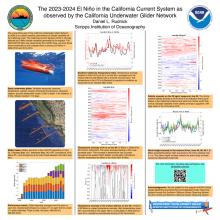The 2023-2024 El Niño in the California Current System as observed by the California Underwater Glider Network
Daniel
Rudnick
Scripps Institution of Oceanography
Poster
The evolution of the 2023-2024 El Niño in the CCS will be presented as observed by the California Underwater Glider Network (CUGN). The CUGN uses Spray underwater gliders making repeated dives from to 500 m every 3 hours and 3 km while measuring temperature, salinity, velocity, dissolved oxygen, chlorophyll fluorescence and acoustic backscatter. The CUGN started in 2005 and continuously occupies three cross-shore CalCOFI lines: line 66.7 off Monterey Bay, line 80 off Point Conception, and line 90 off Dana Point. In 2019, two lines were established at the shelf break (CalCOFI station 60) between lines 80 and 90, and on line 56.7 near Bodega Bay. Past El Niños observed by the CUGN include those in 2009-2010 and 2014-2016. These events were distinguished by anomalously high temperatures and low salinities, consistent with anomalously deep isopycnals. Similar anomalies are already being observed in September 2023. During the very strong El Niño in 2015-2016, anomalously salty water was evident on isopycnals in the poleward flowing California Undercurrent, indicating the influence of advection. This effect was not present during the moderate El Niño of 2009-2010, and it will be telling whether this anomalous saltiness is observed in 2023-2024. The several-year El Niño cycle is embedded in longer decadal variability so that the CCS was anomalously fresh during the 2014-2016 El Niño while CCS waters are salty now. Results in the CCS will be presented in the context of conditions in the equatorial Pacific and in the atmosphere to address the processes that lead to local warming.

Poster file
rudnick-poster.pdf
(1.55 MB)
